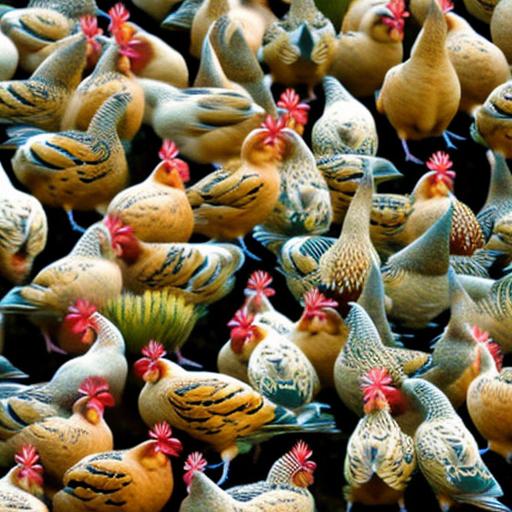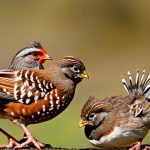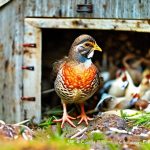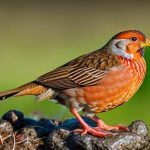Keeping chickens and quails together can be a rewarding experience for poultry enthusiasts. Both chickens and quails are popular choices for backyard farming, and they can coexist in the same environment with proper care and management. Chickens are known for their egg-laying abilities and are often raised for meat, while quails are valued for their small size and efficient egg production. By keeping these two types of birds together, farmers can enjoy a diverse range of poultry products while also creating a dynamic and interesting environment in their backyard.
When considering keeping chickens and quails together, it’s important to understand the compatibility of these two species, create an ideal environment for them to thrive, provide proper nutrition, consider health considerations, and manage their behavior and social dynamics. By addressing these key aspects, poultry enthusiasts can successfully keep chickens and quails together and enjoy the benefits of both species.
Key Takeaways
- Chickens and quails can be kept together in the same environment, but it requires careful planning and consideration of their compatibility and needs.
- Understanding the social dynamics and behavior of chickens and quails is crucial for creating a harmonious living environment for both species.
- Providing a suitable environment with separate areas for nesting, roosting, and dust bathing is essential for keeping chickens and quails together.
- A balanced diet with appropriate nutrition is important for the health and well-being of both chickens and quails when kept together.
- Regular monitoring and preventive measures are necessary to ensure the health and safety of chickens and quails living together.
Understanding the Compatibility of Chickens and Quails
Before deciding to keep chickens and quails together, it’s essential to understand the compatibility of these two species. Chickens are generally larger and more dominant birds, while quails are smaller and more timid. This size and temperament difference can impact their ability to coexist peacefully. However, with proper management and space, chickens and quails can live together harmoniously.
It’s important to provide enough space for both chickens and quails to move around freely without feeling crowded or stressed. Additionally, providing hiding spots and separate feeding areas can help minimize potential conflicts between the two species. Understanding the natural behaviors of chickens and quails is also crucial in creating a compatible environment for them. Chickens are known for scratching and dust bathing, while quails prefer to forage close to the ground. By providing appropriate substrate and environmental enrichment, poultry enthusiasts can cater to the natural instincts of both chickens and quails, promoting a harmonious coexistence.
Creating the Ideal Environment for Chickens and Quails
Creating the ideal environment for chickens and quails is essential for their overall well-being and productivity. Both species require adequate shelter, protection from predators, access to clean water, and appropriate nesting areas. When housing chickens and quails together, it’s important to provide separate nesting boxes to prevent competition for laying eggs. Additionally, ensuring that the coop or housing structure is secure and predator-proof is crucial for the safety of both chickens and quails.
Proper ventilation and lighting are also important factors to consider when creating the ideal environment for chickens and quails. Good air circulation helps prevent respiratory issues, while adequate lighting promotes healthy egg production. Providing a balanced mix of natural light and artificial light can help maintain a consistent laying cycle for both chickens and quails.
In terms of outdoor space, it’s important to provide a secure area for chickens and quails to roam and forage. Fencing off specific areas can help prevent potential conflicts between the two species while allowing them to enjoy the benefits of free-ranging. Providing a variety of perches, dust bathing areas, and hiding spots can also enrich the environment for both chickens and quails, promoting their natural behaviors and overall well-being.
Feeding and Nutrition for Chickens and Quails
Feeding and nutrition play a crucial role in the health and productivity of chickens and quails. Both species have specific dietary requirements that need to be met to ensure optimal growth, egg production, and overall health. When keeping chickens and quails together, it’s important to provide a balanced diet that caters to the nutritional needs of both species.
Chickens are omnivores and require a diet that includes a mix of grains, protein, vitamins, and minerals. Commercial poultry feeds formulated for laying hens are suitable for chickens, providing the necessary nutrients for egg production. Additionally, supplementing their diet with kitchen scraps, greens, and occasional treats can help keep chickens healthy and engaged.
Quails have similar dietary requirements but in smaller portions due to their smaller size. Quail feeds formulated specifically for their nutritional needs are available and should be provided to ensure proper growth and egg production. Additionally, offering small insects, seeds, and greens can help supplement their diet and provide enrichment.
When feeding chickens and quails together, it’s important to provide separate feeding areas to prevent competition and ensure that each species has access to their specific dietary requirements. Monitoring their food intake and making adjustments based on their individual needs can help maintain optimal health and productivity for both chickens and quails.
Health Considerations for Keeping Chickens and Quails Together
Maintaining the health of chickens and quails is essential when keeping them together. Both species are susceptible to various diseases, parasites, and health issues that require regular monitoring and preventative measures. When housing chickens and quails together, it’s important to implement biosecurity practices to minimize the risk of disease transmission between the two species.
Regular health checks, vaccinations, and parasite control are essential components of maintaining the health of chickens and quails. Monitoring their behavior, egg production, appetite, and overall appearance can help identify potential health issues early on. Providing a clean living environment, regular cleaning of nesting areas, and proper waste management can also help prevent the spread of diseases.
It’s important to be aware of common diseases that affect chickens and quails, such as respiratory infections, coccidiosis, and external parasites. Understanding the symptoms of these diseases and seeking veterinary care when necessary is crucial in maintaining the health of both species. Additionally, providing a balanced diet, access to clean water, and proper environmental enrichment can help boost their immune systems and overall well-being.
Managing Behavior and Social Dynamics
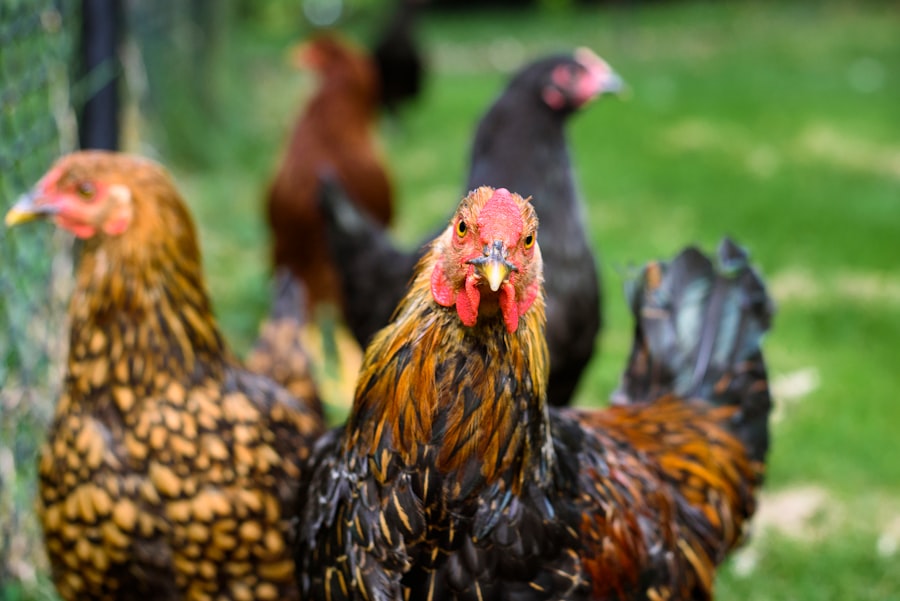
Understanding the behavior and social dynamics of chickens and quails is important in maintaining a harmonious environment when keeping them together. Chickens have a hierarchical social structure with established pecking orders, while quails are more social but can be territorial at times. Providing enough space, hiding spots, perches, and environmental enrichment can help minimize potential conflicts between the two species.
When introducing new birds or integrating different age groups, it’s important to monitor their interactions closely to prevent aggression or bullying. Providing multiple feeding areas can help reduce competition for food, while offering distractions such as hanging treats or toys can keep both chickens and quails engaged and occupied.
It’s also important to consider the breeding behaviors of both species when managing their social dynamics. Chickens may become broody or aggressive during breeding season, while quails may exhibit territorial behaviors when nesting. Providing separate nesting areas and monitoring their interactions during breeding periods can help minimize potential conflicts.
Overall, understanding the natural behaviors of chickens and quails is crucial in managing their social dynamics when keeping them together. By providing a well-designed environment that caters to their individual needs and behaviors, poultry enthusiasts can promote a harmonious coexistence between chickens and quails.
Tips for Successfully Keeping Chickens and Quails Together
Successfully keeping chickens and quails together requires careful consideration of their compatibility, creating an ideal environment, providing proper nutrition, maintaining their health, and managing their behavior. By understanding the unique needs of both species and addressing these key aspects, poultry enthusiasts can enjoy the benefits of keeping chickens and quails together in their backyard.
Some tips for successfully keeping chickens and quails together include providing enough space for both species to move around freely without feeling crowded or stressed. Creating separate nesting areas, feeding spots, perches, hiding spots, dust bathing areas, and environmental enrichment can help cater to the natural behaviors of both chickens and quails while minimizing potential conflicts.
Additionally, monitoring their health regularly, providing a balanced diet that meets their specific nutritional needs, implementing biosecurity practices, seeking veterinary care when necessary, and managing their social dynamics can help maintain a harmonious environment for both chickens and quails.
In conclusion, keeping chickens and quails together can be a rewarding experience when done with proper care and management. By understanding their compatibility, creating an ideal environment, providing proper nutrition, maintaining their health, and managing their behavior, poultry enthusiasts can successfully keep chickens and quails together in their backyard while enjoying the benefits of both species.
If you’re considering keeping chickens and quails together, it’s important to ensure that their coop is well-insulated to provide a comfortable environment for both species. To learn more about how to properly insulate a chicken coop, check out this informative article on PoultryWizard. Proper insulation can help regulate the temperature inside the coop, which is essential for the health and well-being of your feathered friends.
FAQs
Can you keep chickens and quails together?
Yes, it is possible to keep chickens and quails together in the same coop or living space.
What are the benefits of keeping chickens and quails together?
Keeping chickens and quails together can provide a diverse range of eggs for consumption. Additionally, they can help keep each other company and provide entertainment for each other.
Are there any potential issues with keeping chickens and quails together?
There can be potential issues with keeping chickens and quails together, such as differences in dietary needs and potential aggression between the two species. It is important to monitor their interactions and provide separate feeding areas if necessary.
What should be considered when keeping chickens and quails together?
When keeping chickens and quails together, it is important to consider the space requirements, dietary needs, and potential for aggression between the two species. Providing separate areas for feeding and nesting can help minimize potential issues.
Can chickens and quails share the same feed?
While chickens and quails can share some of the same feed, it is important to provide a balanced diet for each species. Quails have specific dietary needs, such as higher protein levels, that may not be met by standard chicken feed. It is important to provide a balanced diet for both species to ensure their health and well-being.
Meet Walter, the feathered-friend fanatic of Florida! Nestled in the sunshine state, Walter struts through life with his feathered companions, clucking his way to happiness. With a coop that’s fancier than a five-star hotel, he’s the Don Juan of the chicken world. When he’s not teaching his hens to do the cha-cha, you’ll find him in a heated debate with his prized rooster, Sir Clucks-a-Lot. Walter’s poultry passion is no yolk; he’s the sunny-side-up guy you never knew you needed in your flock of friends!

